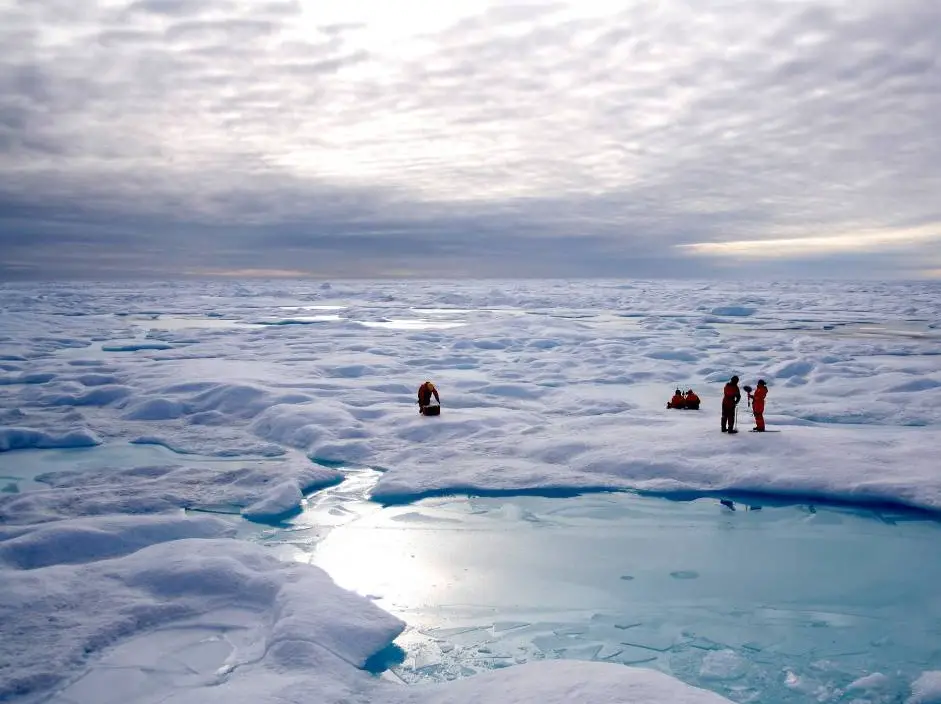In an international collaborative project, Knies has studied the historic emergence of the ice in the Arctic Ocean. The results are published in Nature Communications.
“We have not seen an ice free period in the Arctic Ocean for 2,6 million years. However, we may see it in our lifetime.” says marine geologist Jochen Knies.
The extent of sea ice cover in Arctic was much less than it is today between four and five million years ago. The maximum winter extent did not reaching its current location until around 2.6 million years ago. This new knowledge can now be used to improve future climate models.
“We have not seen an ice free period in the Arctic Ocean for 2,6 million years. However, we may see it in our lifetime. The new IPCC report shows that the expanse of the Arctic ice cover has been quickly shrinking since the 70-ies, with 2012 being the year of the sea ice minimum”, Jochen Knies.

He is marine geologist at the Geological Survey of Norway (NGU) and Centre for Arctic Gas Hydrate, Climate and Environment, UiT The Arctic Univeristy of Norway.
In an international collaborative project, Jochen Knies has studied the trend in the sea ice extent in the Arctic Ocean from 5.3 to 2.6 million years ago. That was the last time the Earth experienced a long period with a climate that, on average, was warm before cold ice ages began to alternate with mild interglacials.
Fossils reveal past sea ice extent
“When we studied molecules from certain plant fossils preserved in sediments at the bottom of the ocean, we found that large expanses of the Arctic Ocean were free of sea ice until four million years ago,” Knies tells us.
“Later, the sea ice gradually expanded from the very high Arctic before reaching, for the first time, what we now see as the boundary of the winter ice around 2.6 million years ago ,” says Jochen Knies, who is also attached to CAGE, the Centre for Arctic Gas Hydrate, Environment and Climate at the University of Tromsø, the Arctic University of Norway.
Arctic Ocean likely to be completely free of sea ice
The research is of great interest on the international stage because present-day global warming is strongly tied to a shrinking ice cover in the Arctic Ocean. By the end of the present century, the Arctic Ocean seems likely to be completely free of sea ice, especially in summer.
This may have major significance for the entire planet ‘s climate system. Polar oceans , their temperature and salinity, are important drivers for world ocean circulation that distributes heat in the oceans. It also affects the heat distribution in the atmosphere. Trying to anticipate future changes in this finely tuned system, is a priority for climate researchers. For that they use climate modeling , which relies on good data.
“Our results can be used as a tool in climate modelling to show us what kind of climate we can expect at the turn of the next century. There is no doubt that this will be one of many tools the UN Climate Panel will make use of, too. The extent of the ice in the Arctic has always been very uncertain but, through this work, we show how the sea ice in the Arctic Ocean developed before all the land-based ice masses in the Northern Hemisphere were established,” Jochen Knies explains.
Seabed samples from Spitsbergen
A deep well into the ocean floor northwest of Spitsbergen was the basis for this research. It was drilled as part of the International Ocean Drilling Programme, (IODP), to determine the age of the ocean-floor sediments in the area. Then, by analysing the sediments for chemical fossils made by certain microscopic plants that live in sea ice and the surrounding oceans, Knies and his co-workers were able to fingerprint the environmental conditions as they changed through time.
“One thing these layers of sediment enable us to do is to “read” when the sea ice reached that precise point,” Jochen Knies tells us.
The scientists believe that the growth of sea ice until 2.6 million years ago was partly due to the considerable exhumation of the land masses in the circum-Arctic that occurred during this period. “Significant changes in altitudes above sea level in several parts of the Arctic, including Svalbard and Greenland, with build-up of ice on land, stimulated the distribution of the sea ice,” Jochen Knies says.
“In addition, the opening of the Bering Strait between America and Russia and the closure of the Panama Cannel in central America at the same time resulted in a huge supply of fresh water to the Arctic, which also led to the formation of more sea ice in the Arctic Ocean,” Jochen Knies adds.
All the large ice sheets in the Northern Hemisphere existed around 2.6 million years ago.
Tromso, University of (Universitetet i Tromsø – UiT)




